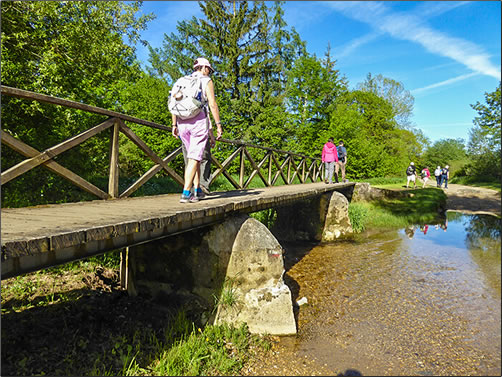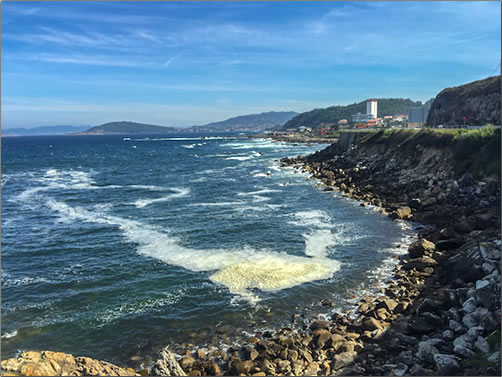So Many Camino Ways to Santiago de Compostela!

The distinctive terrain on each route may help decide which one to choose
By Geraldine O’Callahan
Images courtesy of followthecamino.com
Did you think that the Camino de Santiago consists of one or two routes leading to the beautiful medieval town of Santiago de Compostela in northwest Spain? In fact, it consists of a large network of paths converging into Spain from across Europe, all with a history many hundreds of years old. Some paths are quite short like the Camino Inglés (119 kilometers) and others much longer ranging up to 1,000 kilometers like the Via de la Plata starting in Spain’s south. Neither are they all equal in their physical challenges. This article considers the types of terrain that each route has to offer the pilgrim or active traveler whether planning to walk, cycle or ride a horse to reach the end-goal of Santiago de Compostela.

Via Podiensis (Le Puy Route crossing Southern France)

The Via Podiensis or the Le Puy Route extends approximately 690 km crossing southwest France to the French-Spanish border. It is famous for its beautiful terrain and architecture. The route begins in the high plateaus of France’s Massif Central which involves steep climbs through woodland and villages. After that, the route includes long walks through agricultural land, open grassland, and vineyards and along rivers and canals. In the French Basque region the terrain becomes mountainous upon approaching the Pyrenees and the start of the Camino Francés. Although this walk contains long stretches of easy walks, the rugged, mountainous regions with long, steep climbs and descents make it a challenging but rewarding walk.
Camino Francés (French Border to Santiago de Compostela)

The Camino Francés or the French Way is the classic Camino and stretches approximately 780 km across northern Spain. Over 60% of pilgrims choose the Camino Francés because it is the route where you can get the most of the “pilgrim experience”. It begins with a strenuous hike over the foothills of the Pyrenees. From there it follows hilly, woodland paths and winds through the fields, villages, and towns of Navarra and Rioja. The route then climbs to the high plateau of the Meseta in Castille and Leon. Here the exposed, treeless route consists of long stretches of nearly flat dirt or gravel paths through sparsely populated agricultural land. This area also contains long walks through the beautiful cities of Burgos and Leon. After leaving the Meseta, the route crosses the Montes de Leon into Galicia. The path through Galicia includes steep, rocky ascents and descents, open upland, wooded paths, and small rural roads through pastures and villages. Rural tranquillity yields to excitement with a sweeping descent by road into Santiago.
Camino del Norte (Spain’s North Coastal Route)

The Camino del Norte or the Northern Way is a 465 km world of extremes. The first section extends from San Sebastian to Bilbao in the Basque Country. It takes in many types of terrain including grassy fields, rolling hills, country lanes, coastlines, forests, villages, and jagged mountains. After leaving the city and suburbs of Bilbao, the terrain becomes less strenuous but still dramatic. The paths wind along coastal cliffs, occasional steep hills, and flat walks along marshland and beaches before reaching Santander. After Santander the route meanders through meadows and villages and along the wild Cantabrian and Asturian coast. It then heads inland to Oviedo and the start of the Camino Primitivo.
Camino Primitivo (The Original Way)

The approximately 330 km Camino Primitivo or Original Way begins in hilly farmland and villages before crossing the Cantabrian Mountains. This challenging section is wild, wooded, and sparsely populated with long ascents and descents on roads and paths. As the route descends from Asturias into Galicia, walking becomes easier with a return to farmland, villages, towns, and forests. The Primitivo joins the Camino Francés in Melide, about 40 km from Santiago. From there it consists of forest tracks, villages, and quiet country roads before entering the more developed environs of Santiago.
Via de la Plata (Southern Spain from Sevilla to Santiago)

The nearly 1000 km Via de la Plata is a land of extremes with an unparalleled variety in types of terrain. After starting in urban Andalucia, the route quickly gains elevation and enters into the dry, rocky parks and agricultural land of Extremadura. Here the path follows dusty tracks and remnants of Roman roads over mountains and across large areas of sparsely populated high plateau. The terrain here is exposed with little shade. Upon descending the plateau and entering Castille y Leon, the landscape becomes greener with more frequent towns and villages. The terrain is also more challenging with steep climbs and descents upon entering Galicia. This is “green Spain” with its forests, fields, and mountain villages. Here is a lush mix of everything from shady paths to quiet, country roads to national roads ushering you into Santiago.
Camino Inglés (The English Way)

The Camino Inglés from Ferrol is a short route of only 119 km and lies entirely within the green, misty land of northwest Galicia. However, it has variable types of terrain ranging from hilly coastlines and estuaries near Ferrol to steep climbs into the mountains on gravel and dirt paths. The wooded mountains and villages then give way to paved paths on the outskirts of Santiago, arriving from the north.
Camino Portuguese

The 600 km Camino Portuguese or Portuguese Central Way begins from Lisbon at low elevation heading north with easy walks through river valleys. It then enters first hilly and then more mountainous terrain as it approaches Porto. The route here consists of everything from wooded paths to Roman roads to urban pavement. Once the route leaves the nearly flat Atlantic region north of Porto, it enters the hillier and greener lands of northern Portugal and Spain’s Galicia. Here the route consists of gently undulating woodlands and agricultural regions with cobbled country roads and dirt tracks. The steeper slopes and rural villages of Galicia provide a verdant landscape as one approaches the ultimate destination of Santiago.
Camino Portuguese Coastal Route

The types of terrain on the 240 km Camino Portuguese Coastal are a contrast to those found on other routes. The route as it leaves Porto is nearly flat with only occasional small hills. The walk along the coast is a mix of paved footpaths through towns, forest tracks, and cobbled country roads. It’s also possible to walk along miles of pristine beach or long stretches of wooden boardwalks within the sand dunes. Once you cross the border into Spain, the gently undulating route follows the coast northwards before turning inland and becoming increasingly hilly. The Coastal Route joins the Portuguese Central Way at Redondela. From there it meanders through the green hills of Galicia to Santiago de Compostela.
Camino Finisterre

The 89 km route to Finisterre is the only one usually pursued AFTER completing one of the paths to Santiago de Compostela and it does not earn the walker a pilgrim certificate because the length is not sufficient. However, some active travelers consider Finisterre on the windswept northwest tip of Spain to be the ultimate finish point of the Camino where it drops into the Atlantic Ocean. The terrain consists of long walks along dirt tracks and quiet, paved country roads through occasional small villages. The path through this green, undulating landscape concludes with a final big descent to the Atlantic coast at Cee. After climbing up and down one more headland, Finisterre is in sight. It’s then a short 3 km road walk from the town to the lighthouse at Cabo Finisterre to watch the sunset.
Follow Up FactsFollow the Camino, www.followthecamino.com, organises guided and self-guided (easy to challenging) European walking and cycling holidays for adventure seekers the world over. There is a great range of walks and cycling options for all ages, in particular on the famous Camino de Santiago. The company was the first ever tour operator to offer the Camino de Santiago by creating manageable sections along the main routes to Santiago de Compostela. Each walking or cycling route is divided into 6 or 7 days, with a manageable number of kilometers each day. Carefully selected and regularly assessed accommodations each night (family owned hotels, genuine guest houses or great pensions) reflect the social and cultural scene with the freshest local food and drinks. Since 2006 Follow the Camino has organised tours for thousands of pilgrims and holiday makers, even for those interested in horse riding a section of the Camino! Of their clients, 23% are over 60 years of age and 56% are between 30 and 60 years old.
The largest collection of destination articles in our web magazine’s Travel Article Library celebrates our senior travel readers’ strong interest in meeting the challenge of the Camino. There you will find insightful personal journeys along the Camino, from independent to self-guided to fully-guided options of different lengths. Now that you know about the type of terrain that different routes offer, we invite you to check out our other articles that will expand your understanding and appreciation of this life changing experience.
With a passion for travel and an ear for languages, Geraldine O’Callaghan is a travel writer who has sampled a number of sections of the Camino. She is also Follow the Camino’s Communications Manager based in Dublin, Ireland. Having lived in Spain, Geraldine speaks fluent Spanish and is happy to skip along the Camino de Santiago at the drop of a hat. Email: Geraldine@followthecamino.com.
